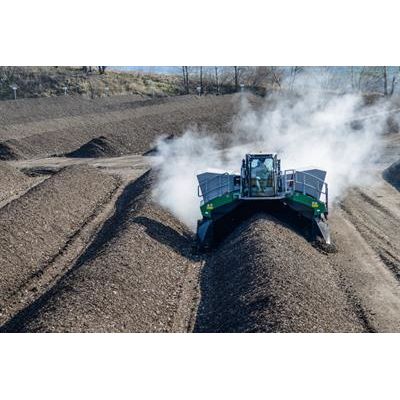

- Home
- Companies
- Komptech GmbH
- Applications
- Waste handling solutions for the ...

Waste handling solutions for the composting industry - Waste and Recycling - Composting
The purpose of composting is to decompose organic substances as efficiently and odourlessly as possible, to convert them into a stable, plant-friendly, high-quality humus product in a controlled rotting process that is as efficient, short and low-emission as possible.
Preparation
By shredding, mixing and, where required, screening, a blend is produced that is as free as possible from contraries and is optimised for the rotting process.
Rotting process
The decomposition and conversion process, performed by microorganisms, is controlled from outside by ventilating, mixing and watering.
Post treatment
Screening and wind sifting guarantee compost with a homogenous particle size and free of contraries.
Shredding to the Right Particle Size
Low-speed machines like the Crambo or high-speed ones like the Axtor are used for shredding. Both types can be adjusted to output the desired particle size, using the appropriate screen baskets and teeth. This step can be enclosed or open-air, depending on the input material and local conditions.
Cleaning & Mixing
Drum screens, Multistar star screens and Flowerdisc disc separators separate off contraries and noncompostable fractions. At windrow composting the material is mixed with structure material and screen oversize during the layered build-up with a wheel loader and homogenized in subsequent mixing with a turner.
Open Or Closed
The input material and the associated limiting factors also decide for the rotting process whether it is conducted closed, i.e. in an indoor part of the system, or open as windrow composting.The first phase of the process often takes place in a closed system with ventilation and outlet air treatment.
Windrow Composting
Turning compost with a Topturn compost turner improves ventilation, enables re-watering and ensures mixing of the different rotting areas in the windrow. The process is generally complete after 6 to 12 weeks.
Screening
To attain a product of uniform particle size, and to separate off any contraries still present, the compost is screened. Komptech has a wide range of mobile and stationary drum and star screening machines for this process.The particle size produced is based on the intended use, ranging from coarse compost fractions for agriculture to finely screened material for mixing into garden and potting soil.
Sifting of the Overflow
Screening after composting generates a usable fraction and a screen overflow. The overflow can be run through a Hurrikan windsifter to remove the light components and then used as structure fill, or it can be used as biomass fuel once the stones have been removed by a Stonefex. The new Hurrifex does both tasks in one step.
